Objective of the Experiment
The primary objective of carrying out this experiment is to examine how alcohols undergo substitution reactions. In particular, the experiment uses 1-butanol to examine the formation of 1-bromobutane through a nucleophilic substitution reaction.
The following equation provides a summary of the nucleophilic substitution reaction involving 1-Butanol and hydrogen bromide.
Synthetic Equation

Several components were used during this experiment, and they included 1-butanol, hydrogen bromide, water, sodium bicarbonate, sodium sulfate, and 1-bromobutane. The following section highlights the form, molecular formula, melting point, boiling point, hazards, density, as well as the solubility of each of the components.
Physical Properties
1-Butanol1. 1-Butanol is a colorless liquid whose molecular formula and density are C4H10O and 0.81g/mL respectively. Based on this formula, the molecular weight of 1-Butanol is 74.12. The figure below shows the molecular structure of this compound.
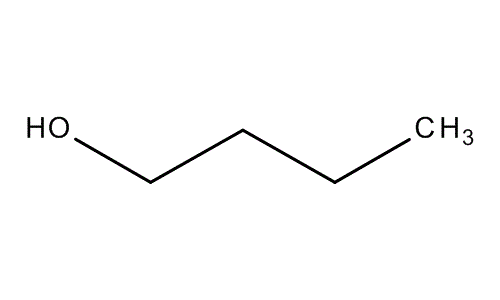
The melting point and the boiling points of this compound are -89℃, and 117.6℃ respectively. In addition, 1-Butanol’s solubility in water at 20℃ is 80g/L. This substance is harmful, toxic, and highly flammable.
Hydrogen Bromide2. Hydrogen bromide exists as a colorless oily liquid whose molecular formula and density are HBr and 1.49g/mL respectively. Based on this formula, the molecular weight of HBr is 80.91. The figure below shows the molecular structure of this compound.
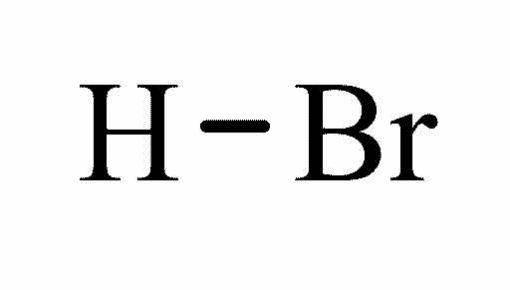
The melting point and the boiling points of this compound are -87℃, and -67℃ respectively. In addition, hydrogen bromide is miscible in water at 20℃ is 80g/L. However, it is corrosive and has irritating characteristics.
Sulfuric Acid3. Sulfuric acid is a colorless oily liquid whose molecular formula and density are H2SO4 and 1.84g/mL respectively. The molecular weight of sulfuric acid based on its formula is 98.08. The figure below shows the molecular structure of H2SO4.
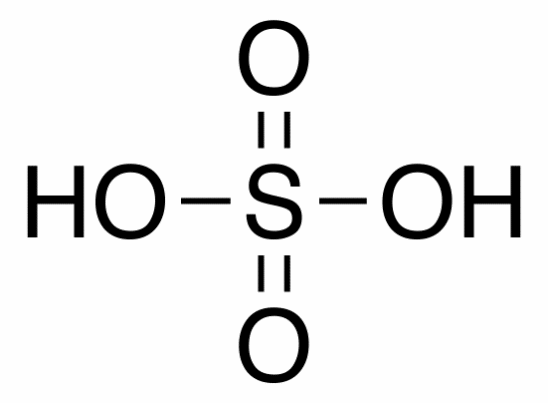
This chemical has a low melting point of 10℃ but a high boiling point of 290℃. It can mix with water at 20℃. On the other hand, sulfuric acid is corrosive, highly flammable, toxic, and has irritating characteristics.
Sodium Bicarbonate4. Sodium bicarbonate is a white powder whose molecular formula and density are NaHCO3 and 2.16g/mL respectively. The molecular weight of sodium bicarbonate based on its formula is 84.01. The figure below shows the molecular structure of NaHCO3.
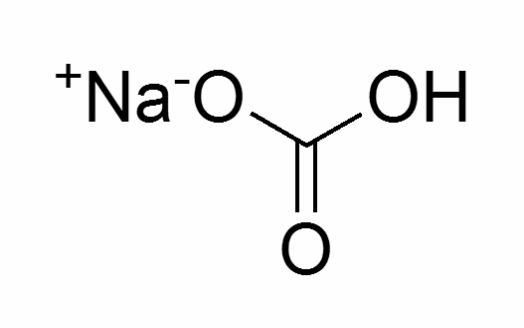
Sodium bicarbonate has high melting and boiling points of 300℃ and 851℃, respectively. Its solubility in water at 20℃ is 90g/L. Sodium bicarbonate is highly toxic and has irritating characteristics.
Sodium Sulfate5. Sodium sulfate exists in the form of either powder or crystals that are white in color. Its molecular formula and density are Na2SO4 and 2.68g/mL respectively. The molecular weight of sodium sulfate based on its formula is 142.04. The figure below shows the molecular structure of Na2SO4.

Sodium sulfate has a high melting and boiling points of 884℃ and 1700℃, respectively. Its solubility in water at 20℃ is 18mg/L. It is an irritant.
1-Bromobutane6. 1-Bromobutane is a colorless liquid. In spite of this, its impure samples are yellow in color. It is insoluble in water soluble in organic solvents. Its solubility in water at 20℃ is 0.608g/L. The molecular formula and density of 1-bromobutane are C4H9Br and 1.276g/mL respectively. The molecular weight of sodium sulfate based on its formula is 137.02. The figure below shows the molecular structure of C4H9Br.
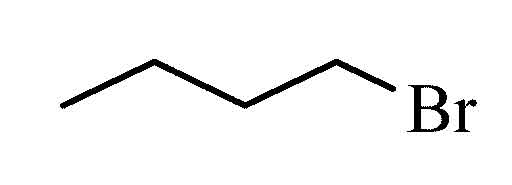
1-Bromobutane has a low melting point of –112℃ while its boiling point ranges between 100℃ and 101℃. It is a highly flammable irritant, which is dangerous for the environment.
Procedure
As stated early, this experiment was aimed at examining substitution reactions involving the formation of 1-bromobutane from 1-butanol. For this reason, several reagents such as hydrogen bromide, 1-butanol, concentrated sulfuric acid, sodium bicarbonate, and sodium sulfate were used.
The procedure included 6.2ml of 1-butanol measured into a 100ml round bottom flask. Secondly, 10 ml of 48% hydrogen bromide (HBr) was added to the round bottom flask that contained the 1-butanol, while swirling it. In addition, about 4ml of concentrated sulfuric acid (H2SO4) was added to the flask slowly while at the same time swirling the contents of the flask before cooling it in an ice bath. After this, two boiling chips were added to the flask and a reflux condenser connected to the top of the round bottom flask with water tubes. In addition, a vacuum tube was fixed at the top of the reflux condenser for the purpose of absorbing any poisonous fumes that would come out during the reaction. However, one end of the vacuum was left unconnected and used to connect the apparatus to a sink aspirator using a gas trap.
After everything had been set up, the aspirator was switched on and set to full blast. The functionality of the aspirator was tested by placing a finger on the open joint of the vacuum to examine any possible suction. Then, the contents of the flask were heated at reflux for about 45 minutes before allowing the reaction mixture to cool in an ice-cold bath. About 10ml of de-ionized water was carefully added to the condenser followed by two boiling chips to the mixture.
The initial apparatus was disconnected and a simple distillation apparatus set up. This was done by disconnecting the vacuum and using a 25ml round bottom flask to collect the distillate. The flask was fully covered in an ice bath. However, after the distillate’s temperature reached 100℃, the distillation process was stopped and the aqueous layer in the flask removed through the use of a transfer pipette.
In addition, about 5ml of de-ionized water were added to the organic layer using a transfer pipette while at the same time the aqueous layer that was obtained was mixed with previous layer. The two layers were washed with 5ml of 5% sodium bicarbonate. Further, another 5ml of de-ionized water was mixed with the organic mixture while the aqueous layer was removed and mixed with the previous aqueous layer in the flask. On the other hand, the organic layer that remained in the flask was removed and dried using anhydrous sodium sulfate. A pre-weighed sample bottle with a cap was used to measure the weight of the organic product. It was necessary to measure the weight of the product in the sample bottle in order to obtain the results. Moreover, the IR of the product was determined and the percentage yield calculated.
Results
Calculation of Theoretical and Percent Yields
- Theoretical yield:
Mass = density × Volume
Thus, the mass of 1-butanol = density of 1-butanol × Volume of 1-butanol used
= 0.81 g/mL × 6.2 mL = 5.022g
No. of moles = Mass/molecular weight
Thus, Moles of 1-butanol = 5.022g / 74.12 g/mol = 0.0677 mol
Theoretical yield = (0.0677 mol ×137.02 g/mol) / 1 mol of 1-bromobutane = 9.28g - Percent yield:
Weight of empty sample bottle plus lid = 25.05 g
Sample bottle+ product + lid = 31.75 g
Mass of the product= (Sample bottle+ product + lid) – (empty sample bottle plus lid)
= 31.75g – 25.05g
= 6.7g
Percent yield = (Actual yield/ theoretical yield) × 100
= (6.7g/9.28g) × 100= 72.2 %
Synopsis of the Results
A review of the experimental results indicates that there is a significant difference between the theoretical yield and the empirical yield of 1-bromobutane. While the theoretical yield was found to be 9.28g, its empirical yield was 6.7g. In addition, comparing the yield of 1-bromobutane obtained and the mass of 1-butanol used, it is evident that 1-bromobutane yield of 6.7g represents 72.2% of the theoretical yield. The difference in the theoretical and empirical yields can be attributed to a number of experimental factors. For example, the low yield of 1-bromobutane can be explained by the failure of all molecules of 1-butanol to be converted to 1-bromobutane.
There was a significant difference in the IR spectra before and after the reaction. An analysis of the IR spectra before and after the substitution reaction revealed that there were noticeable changes in the O-H stretch and wavenumbers 3200cm-1 and 3500cm-1. Prior to the reaction, the IR spectrum for the O-H stretch was broad and attained its peak value at 3318.33cm-1, and had a transmittance of about 80%. On the other hand, the IR spectrum for the O-H stretch after the reaction was moderate and attained its peak value at 3358.49cm-1 while the transmittance was about 98%. The high transmittance value and a large wavenumber indicate the presence of 1-butanol, implying that some molecules of 1-butanol did not react.
The exposure of 1-butanol to a lot of heat in the course of the experiment would have led to the evaporation of some 1-butanol molecules. On the other hand, a significant quantity of 1-bromobutane could have escaped during the reaction considering that this compound is quite volatile. Lastly, the distillate was washed using de-ionized water and sodium bicarbonate. As such, there is a high likelihood that a number of 1-bromobutane molecules might have remained in the aqueous layers.
Discussion
The experiment was carried out to examine substitution reactions of alcohols. A substitution reaction refers to a chemical reaction where a single displacement reaction results from the replacement of one functional group by another. Often, such a reaction is either electrophilic of nucleophilic. However, the type of the substitution reaction is determined by the nature of the attacking functional group. A nucleophilic substitution occurs whenever an electrophile acquires a cation to form a stable compound. As such, weak nucleophiles are displaced in a nucleophilic substitution reaction through cationic attack by a strong nucleophile. On the other hand, an electrophilic substitution occurs when a weak electrophile is displaced by a strong electrophile. The implication is that the strength of the functional group in an electrophilic or nucleophilic reaction determines the probability of displacing other functional groups.
According to the results of this experiment, it was evident that the substitution reaction involving 1-butanol in the presence of hydrogen bromide led to the formation of 1-bromobutane. An acidic environment enhances the occurrence of substitution reaction of alcohols in the presence of nucleophiles. The 1-butanol, which is a 4-carbon alcohol, was used in this experiment as a representative of all primary alcohols. Hydroxyl (-OH) is the functional group in 1-butanol, while the bromide ion (Br–) is the functional group of the hydrogen bromide. As such, the reaction occurs following the protonation of the –OH group to form a stable leaving group (-OH2). The bromide ion is considered to be a strong nucleophile, and hence, has the ability to attack the already protonated 1-butanol from the opposite side of the leaving group (-OH2), to displace it in the form of a water molecule. As such, the nucleophilic substitution reaction in this case follows SN2 substitution since there is no formation of a carbocation.
The set-up of the experiment included a gas trap that was used to trap and direct harmful gases into the water. This can be attributable to the fact that the reaction between hydrogen bromide, sulfuric acid, and 1-butanol in the presence of heat releases harmful gases. The gas trap has enough surface area to allow the collected harmful gases to dissolve easily in water. In the case of this experiment, the gas trap was useful in collecting the gaseous vapor of 1-butanol, hydrogen bromide, and sulfuric acid.
The mixture of all the three reagents was heated under reflux to prevent reagents from escaping. In most cases, reflux heating applies whenever volatile reagents are used in an experiment. A simple distillation process was used to enhance the separation of organic and inorganic products. The distillation process was stopped at a temperature of 100℃ since it is the boiling point of 1-bromobutane. In the event that the distillation process was allowed to exceed 100℃, other compounds would have been found in the distillate making the collection of pure 1-bromobutane impossible.
Thus, the distillation process should stop at 100℃ for the distillate to contain 1-bromobutane as the only organic product.
1-bromobutane has a density of 1.276g/ implying that it is less dense than the aqueous layers. For this reason, it was possible to separate the two layers based on their difference in densities. In this case, the aqueous layer is considered to have a high density in comparison to the organic layer due to the fact that it contains molecules of 1-butanol, sulfuric acid, and any other inorganic salts. The organic layer was washed with de-ionized water to eliminate acid residues. Sodium bicarbonate was used to wash the organic layer to neutralize any molecules of sulfuric acid that might have passed to the distillate. In addition, washing the organic layer with de-ionized water eliminated any traces of sodium bicarbonate. An anhydrous sodium sulfate can absorb water molecules from 1-bromobutane, and for this reason, it was used as the drying agent.
The primary goal of the experiment, which was to prepare 1-bromobutane from the reaction of 1-butanol and hydrogen bromide, was achieved. In spite of this, it was evident that the value of the theoretical yield and the empirical yield varied significantly. Such difference can be attributed to experimental and syntax errors. Some of the most probable errors include the presence of impurities of 1-butanol in the final product, the evaporation of 1-butanol during the heating process, as well as a possible removal of some molecules of 1-butanol from organic layer during washing.
IR was used to analyze the results of the experiment where significant difference was noted in the O-H stretch between 3200cm-1 and 3500cm-1 wavenumbers. Such difference indicated the presence of 1-butanol in the reactants. In the end, it was evident that not all molecules of 1-butanol reacted with the hydrogen bromide to form 1-bromobutane. For this reason, it was expected that the value of the yield of 1-bromobutane would be low in comparison to the empirical value.
References
Chemical Book: 1-bromobutane 2008. Web.
Chemical Book: 1-butanol 2008. Web.
Chemical Book: Hydrogen Bromide 2008. Web.
Chemical Book: Sodium bicarbonate 2008. Web.
Chemical Book: Sodium sulfate 2008. Web.
Chemical Book: Sulfuric acid 2008. Web.
Footnotes
- Chemical Book: 1-butanol 2008. Web.
- Chemical Book: Hydrogen Bromide 2008. Web.
- Chemical Book: Sulfuric acid 2008. Web.
- Chemical Book: Sodium bicarbonate 2008. Web.
- Chemical Book: Sodium sulfate 2008. Web.
- Chemical Book: 1-bromobutane 2008. Web.